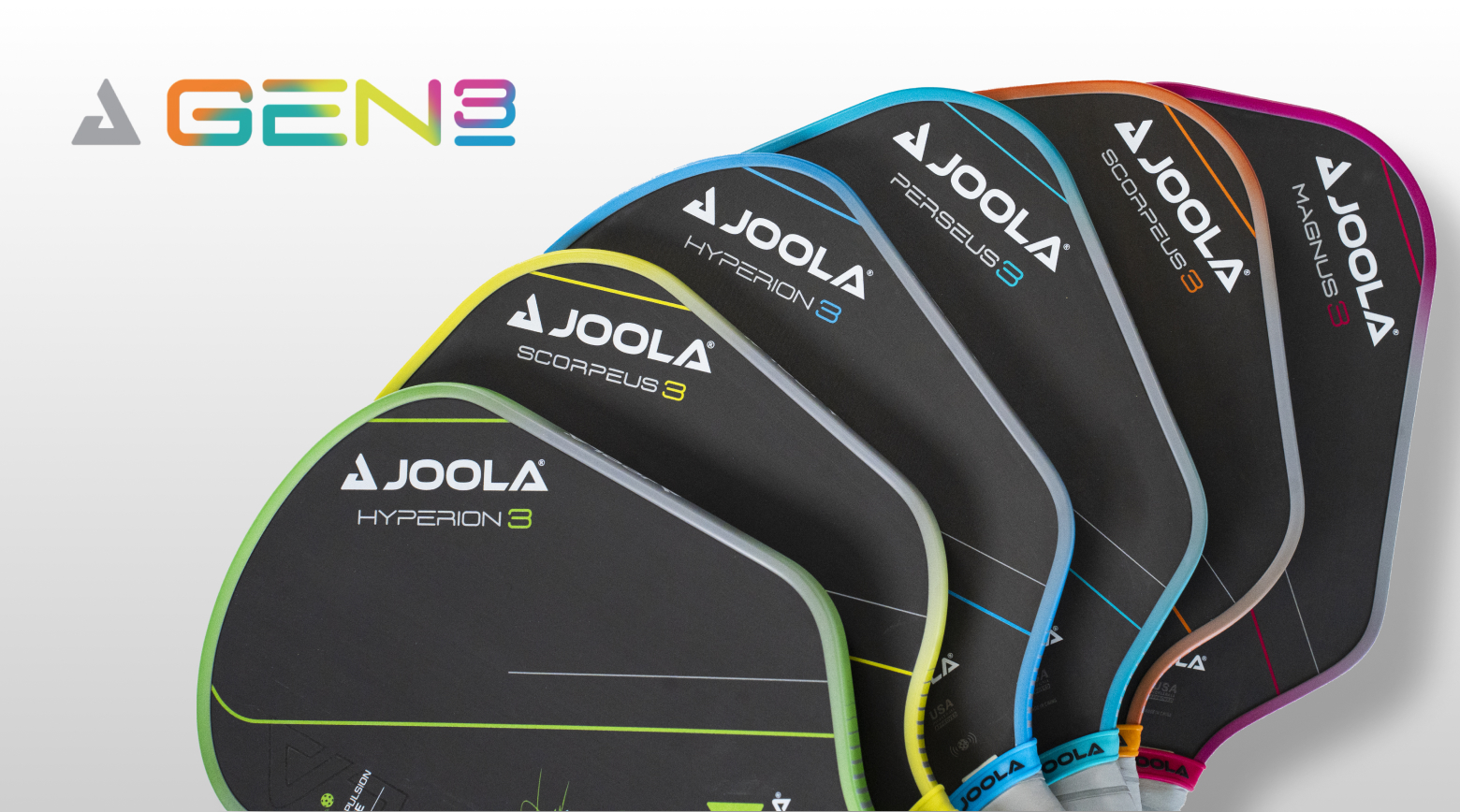Watch our Pong Like A Champ video mini series and get the latest tips from National Champ, Peter Li, on how to improve your game! Tips 1, 2, and 3 were posted on Monday. Click here to read them!
4. Getting Good Equipment
Using equipment that fits your skill level and playing style is essential to improve your game because the right equipment will ensure that you develop the proper strokes in practice and maximize points during games. For racket selection, the two main components to consider are the blade and rubber.
First, it is important to recognize that the word “blade” refers to the wood of the racket. In competitive table tennis, most blades are made up of three, five, or seven thin layers of wood veneers. The type of wood veneers used to construct the blade determines the general feel of the racket and influences the overall speed and spin of the racket. For example, many blades are classified by speed and control. JOOLA uses four levels of speed – low, medium, fast, and extreme. In table tennis, this scale is translated to DEF (defensive), ALL (allround), OFF (offensive), and OFF+, where low is equivalent to DEF, medium is equivalent to ALL, fast is equivalent to OFF, and extreme is equivalent to OFF+. Similarly, the scale for control is defined as low, medium, high, and extra high. It is generally recommended that a defensive player look for a racket with low speed and high control, an allround player look for a racket with medium speed and medium or high control, and an offensive player look for a racket with high speed and medium control.

The other piece to consider is the rubber, which refers to the material glued onto the face of the blade. In terms of the physical appearance, rubbers are separated into two categories – pips-in or pips-out. Pips-in rubbers have smooth surfaces and are capable of generating more spin than pips-out rubbers, which have pimpled surfaces and are mostly used to counter spins. Within the category of pips-out surfaces, there are even more classes, but the two most popular types of pips-out rubbers are short pips and long pips. Short pips are advantageous to fast-paced players who have trouble with heavy spin because they reduce the spin of the incoming shot, making the ball easier to manage. In contrast, long pips counter the spin that is received and are frequently used by choppers who have a defensive playing style.
Regarding built-in technologies, the rubber on a racket adds to the overall speed, spin, and control of the racket. For easy comparison, JOOLA classifies its rubber by speed, spin, and control. Speed is measured as low, medium, fast, and extra fast, while spin and control are both scaled as low, medium high, and extra high. The optimal speed, spin, and control combination is different for every player, but in general, a defensive player should look for rubbers with high spin and control ratings, and an offensive player should look for rubbers with high speed and spin ratings.
When selecting rubber for your racket, you should also consider the thickness of the sponge. As a general rule, thickness of the sponge is directly proportional to the “bounciness” of the rubber. Another factor to consider is the hardness of the sponge. In table tennis, the hardness of the topsheet is measured in degrees. Some players enjoy harder topsheets, which allow them generate their own power, while others prefer softer topsheets, which enable the ball to havemore of a spring effect when it hits the racket.
As mentioned earlier, it’s important to use equipment that suits your playing level. For this reason, many table tennis equipment manufacturers offer a recreational and professional line with a few overlapping rackets. At JOOLA, we have several “bridge” rackets such as the Carbon Pro, Rosskopf Smash, and Wing Pro. Visit joolausa.com to see the official product line of JOOLA North America, a sponsor of USA Table Tennis.
5. Understanding Underspin Vs. Topspin
Ever notice how some shots go into the net while other shots go off the table? This is usually because of the spin on the ball. Underspin and topspin are two of the most popular spins that you will encounter in table tennis.
Underspin – Underspin can be tricky, but only if you don’t identify it in time to react appropriately. Sometimes, you’ll notice that the ball is spinning in the opposite direction, back towards your opponent, even though it is coming towards you. When the shot hits your side of the table, it doesn’t jump towards you. Instead, it will seem like it’s starting to pull back, away from you. If you don’t make contact at the right angle and force, the ball may go straight into the net. This likely happens because the underspin causes the ball to move back away from you as you go in for the shot, which can make you late on the timing. Unless you are able to control or counter the underspin, the ball will bounce straight into the bottom of the net on your return.

Topspin – This is generally the first spin that players learn to use because it is the most straightforward, literally! When the ball has topspin on it, the ball spins towards you as it comes to you. As a result, often times when you hit the ball off the table, it is because there was too much topspin on the ball. Another example is during serve return. If you’re unprepared when an opponent serves a ball with topspin, your shot will probably end up way past the other side of the table. This is because the ball kicks towards you when it contacts your side of the table, so a lack of control can cause the ball to go too long.
Understanding the different spins in the game should help you learn to read and adjust to different situations in the game. Naturally, it will take some time and experience to master, but paying attention to spin can make a huge difference in your performance.
6. Developing The Deep Push

It’s not always possible to make an offensive shot, but that doesn’t mean you can’t use a preemptive strike to keep the point in your control. A common scenario is when an underspin shot comes your way and you find that you’re not in a position to attack. Instead of creating a vulnerable shot for your opponent to take advantage of, you can use a controlled defensive shot like the deep push. Similar to a slice in tennis, the deep push is an at-the-table chop, meant to catch your opponent off guard and create an easy opening for you. For the deep push, it is important to keep your forearm parallel to the table with an open racket, wait for the ball to reach the top of its bounce, and then aim for the top of the net. Essentially, you want to brush the underside of the ball upon contact. A deep push is generally an excellent transitioning shot to set up for a forehand smash. Remember one of the first tips we covered was finding the right opportunity to forehand smash.







